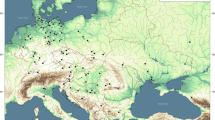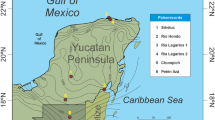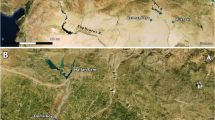Abstract
Wheat and barley evolved from large-seeded annual grasses in the arid, low latitudes of Asia; their spread into higher elevations and northern latitudes involved corresponding evolutionary adaptations in these plants, including traits for frost tolerance and shifts in photoperiod sensitivity. The adaptation of farming populations to these northern latitudes was also a complex and poorly understood process that included changes in cultivation practices and the varieties of crops grown. In this article, we push back the earliest dates for the spread of wheat and barley into northern regions of Asia as well as providing earlier cultural links between East and West Asia. The archaeobotanical, palynological and anthracological data we present come from the Tongtian Cave site in the Altai Mountains, with a punctuated occupation dating between 5,200 and 3,200 calibrated years bp, coinciding with global cooling of the middle–late Holocene transition. These early low-investment agropastoral populations in the north steppe area played a major role in the prehistoric trans-Eurasian exchange.
This is a preview of subscription content, access via your institution
Access options
Access Nature and 54 other Nature Portfolio journals
Get Nature+, our best-value online-access subscription
$29.99 / 30 days
cancel any time
Subscribe to this journal
Receive 12 digital issues and online access to articles
$119.00 per year
only $9.92 per issue
Buy this article
- Purchase on Springer Link
- Instant access to full article PDF
Prices may be subject to local taxes which are calculated during checkout






Similar content being viewed by others
Data availability
All radiocarbon dates and the calibration curve as produced in OxCal are presented in Supplementary Fig. 3; uncalibrated dates and laboratory identification codes are presented in Supplementary Table 1. All quantified macrobotanical data are presented in Supplementary Table 2. Palynological data are all presented in Fig. 5. Archaeobotanical remains are housed at the IVPP in Beijing; these materials are available for further examination upon request. High-quality photos of key specimen are presented in this manuscript.
References
Jones, M. et al. Food globalization in prehistory. World Archaeol. 43, 665–675 (2011).
Motuzaite-Matuzeviciute, G., Staff, R. A., Hunt, H. V., Liu, X. & Jones, M. K. The early chronology of broomcorn millet (Panicum miliaceum) in Europe. Antiquity 87, 1073–1085 (2013).
Spengler, R. N. III Fruit from the Sands: The Silk Road Origins of the Foods We Eat (Univ. of California Press, 2019).
Zhao, Z. Eastward spread of wheat into China—new data and new issues. Chin. Archaeol. 9, 1–9 (2009).
Li, X., Dodson, J., Zhou, X., Zhang, H. & Masutomoto, R. Early cultivated wheat and broadening of agriculture in Neolithic China. Holocene 17, 555–560 (2007).
Sherratt, A. in Contact and Exchange in the Ancient World (ed. Mair, V.) 30–61 (Hawaii Univ. Press, 2006).
Long, T. et al. The early history of wheat in China from 14C dating and Bayesian chronological modelling. Nat. Plants 4, 272–279 (2018).
Atahan, P. et al. Temporal trends in millet consumption in northern China. J. Archaeol. Sci. 50, 171–177 (2014).
Dodson, J. R. et al. Origin and spread of wheat in China. Quat. Sci. Rev. 72, 108–111 (2013).
Dong, G. et al. Prehistoric trans-continental cultural exchange in the Hexi Corridor, northwest China. Holocene 28, 621–628 (2017).
Liu, X. & Jones, M. K. Food globalisation in prehistory: top down or bottom up? Antiquity 88, 956–963 (2014).
Zhou, X., Li, X., Dodson, J. & Zhao, K. Rapid agricultural transformation in the prehistoric Hexi Corridor, China. Quat. Int. 426, 33–41 (2016).
Miller, N. F., Spengler, R. N. III & Frachetti, M. Millet cultivation across Eurasia: origins, spread, and the influence of seasonal climate. Holocene 26, 1566–1575 (2016).
Betts, A., Jia, P. W. & Dodson, J. The origins of wheat in China and potential pathways for its introduction: a review. Quat. Int. 348, 158–168 (2014).
Christian, D. Silk Roads or steppe roads? The Silk Roads in world history. J. World Hist. 11, 1–26 (2000).
Kuzmina, E. E. The Prehistory of the Silk Road: Encounters with Asia (Univ. Pennsylvania Press, 2008).
Frachetti, M. Multi-regional emergence of mobile pastoralism and non-uniform institutional complexity across eurasia. Curr. Anthropol. 53, 2–38 (2012).
Spengler, R. N. & Willcox, G. Archaeobotanical results from Sarazm, Tajikistan, an early Bronze age settlement on the edge: agriculture and exchange. Environ. Archaeol. 18, 211–221 (2013).
Masson, V. M. The first farmers in Turkmenia. Antiquity 35, 203–213 (1961).
Harris, D., Gosden, C. & Charles, M. Jeitun: recent excavations at an early Neolithic site in southern Turkmenistan. Proc. Prehist. Soc. 63, 423–442 (1996).
Spengler, R. N. Agriculture in the central Asian Bronze Age. J. World Prehist. 28, 215–253 (2015).
Spengler, R. et al. Early agriculture and crop transmission among Bronze Age mobile pastoralists of Central Eurasia. Proc. R. Soc. Lond. B 281, 20133382 (2014).
Liu, X. et al. The virtues of small grain size: potential pathways to a distinguishing feature of Asian wheats. Quat. Int. 426, 107–119 (2016).
Matuzeviciute, G. M., Abdykanova, A., Kume, S., Nishiaki, Y. & Tabaldiev, K. The effect of geographical margins on cereal grain size variation: case study for highlands of Kyrgyzstan. J. Archaeol. Sci. Rep. 20, 400–410 (2018).
de Barros Damgaard, P. et al. The first horse herders and the impact of early Bronze Age steppe expansions into Asia. Science 360, 7711 (2018).
de Barros Damgaard, P. et al. 137 ancient human genomes from across the Eurasian steppes. Nature 557, 369–374 (2018).
Haak, W. et al. Massive migration from the steppe was a source for Indo-European languages in Europe. Nature 522, 207–211 (2015).
Kohl, P. L. The Making of Bronze Age Eurasia: Cambridge World Archaeology (Cambridge Univ. Press, 2007).
Anthony, D. W. The Horse, the Wheel, and Language: How Bronze Age Riders from the Eurasian Steppes Shaped the Modern World (Princeton Univ. Press, 2007).
Rühl, L., Herbig, C. & Stobbe, A. Archaeobotanical analysis of plant use at Kamennyi Ambar: a Bronze Age fortified settlement of the Sintashta culture in the southern Trans-Urals steppe. Russ. Veg. Hist. Archaeobot. 24, 413–426 (2015).
Ryabogina, N. E. & Ivanov, S. N. Ancient agriculture in Western Siberia: problems of argumentation, paleoethnobotanic methods, and analysis of data. Archaeol. Ethnol. Anthropol. Eurasia 39, 96–106 (2011).
Frachetti, M. D., Spengler, R. N., Fritz, G. J. & Maryashev, A. N. Earliest direct evidence for broomcorn millet and wheat in the central Eurasian steppe region. Antiquity 84, 993–1010 (2010).
Zhang, J. et al. Cultivation strategies at the ancient Luanzagangzi settlement on the easternmost Eurasian steppe during the late Bronze Age. Veg. Hist. Archaeobot. 26, 505–512 (2017).
Zhao, K., Li, X., Zhou, X., Dodson, J. & Ji, M. Impact of agriculture on an oasis landscape during the late Holocene: palynological evidence from the Xintala site in Xinjiang, NW China. Quat. Int. 311, 81–86 (2013).
Li, C. et al. Ancient DNA analysis of desiccated wheat grains excavated from a Bronze Age cemetery in Xinjiang. J. Archaeol. Sci. 38, 115–119 (2011).
Possehl, G. L. The Middle Asian interaction sphere: trade and contact in the third millennium BC. Expedition 49, 40–42 (2004).
Boivin, N., Fuller, D. Q. & Crowther, A. Old World globalization and the Columbian exchange: comparison and contrast. World Archaeol. 44, 452–469 (2012).
Laufer, B. Sino-Iranica; Chinese Contributions to the History of Civilization in Ancient Iran, with special reference to the history of cultivated plants and products (Field Museum of Natural History, 1919).
Stevens, C. J. et al. Between China and South Asia: a Middle Asian corridor of crop dispersal and agricultural innovation in the Bronze Age. Holocene 26, 1541–1555 (2016).
Hunt, H. V. et al. Genetic diversity and phylogeography of broomcorn millet (Panicum miliaceum L.) across Eurasia. Mol. Ecol. 20, 4756–4771 (2011).
Motuzaite-Matuzeviciute, G., Telizhenko, S. & Jones, M. K. Archaeobotanical investigation of two Scythian-Sarmatian period pits in Eastern Ukraine: implications for floodplain cereal cultivation. J. Field Archaeol. 37, 51–61 (2012).
Cai, D. et al. Ancient DNA analysis of cattle remains from the Houyangwan location at the Shimao site, Shaanxi province. Archaeol. Cult. Relics 4, 122–127 (2016).
Hu, S. et al. Research on animal remains unearthed from Shimao site of Shenmu in Shaanxi province in 2012–2013. Archaeol. Cult. Relics 4, 109–121 (2016).
Petersen, G., Seberg, O., Yde, M. & Berthelsen, K. Phylogenetic relationships of Triticum and Aegilops and evidence for the origin of the A, B, and D genomes of common wheat (Triticum aestivum). Mol. Phylogenet. Evol. 39, 70–82 (2006).
Chen, F. H. et al. Agriculture facilitated permanent human occupation of the Tibetan Plateau after 3600 BP. Science 347, 248–250 (2015).
Mark, A. Peopling the Tibetan plateau: insights from archaeology. High Alt. Med. Biol. 12, 141–147 (2011).
Renssen, H., Seppä, H., Crosta, X., Goosse, H. & Roche, D. Global characterization of the Holocene thermal maximum. Quat. Sci. Rev. 48, 7–19 (2012).
Shakun, J. D. & Carlson, A. E. A global perspective on last glacial maximum to Holocene climate change. Quat. Sci. Rev. 29, 1801–1816 (2010).
Jia, P., Betts, A. & Wu, X. Prehistoric archaeology in the Zhunge’er (Junggar) Basin, Xinjiang, China. Eurasian Prehist. 6, 167–198 (2009).
Berger, A. L. Long-term variations of daily insolation and quaternary climatic changes. J. Atmos. Sci. 35, 2362–2367 (1978).
Wanner, H. et al. Mid-to late Holocene climate change: an overview. Quat. Sci. Rev. 27, 1791–1828 (2008).
Marcott, S. A., Shakun, J. D., Clark, P. U. & Mix, A. C. A reconstruction of regional and global temperature for the past 11,300 years. Science 339, 1198–1201 (2013).
DeMenocal, P. B. Cultural responses to climate change during the late Holocene. Science 292, 667–673 (2001).
Weiss, H. et al. The genesis and collapse of third millennium north Mesopotamian civilization. Science 261, 995–1004 (1993).
Xu, H., Zhou, K. E., Lan, J., Zhang, G. & Zhou, X. Arid Central Asia saw mid-Holocene drought. Geology 47, 255–258 (2019).
Feng, Z. et al. Vegetation changes and associated climatic changes in the southern Altai Mountains within China during the Holocene. Holocene 27, 1–11 (2016).
Chen, F. et al. A persistent Holocene wetting trend in arid central Asia, with wettest conditions in the late Holocene, revealed by multi-proxy analyses of loess–paleosol sequences in Xinjiang, China. Quat. Sci. Rev. 146, 134–146 (2016).
Tao, S. C. et al. Pollen-inferred vegetation and environmental changes since 16.7 ka BP at Balikun Lake, Xinjiang. Sci. Bull. 55, 2449–2457 (2010).
Ran, M., Zhang, C. & Feng, Z. Climatic and hydrological variations during the past 8000 years in northern Xinjiang of China and the associated mechanisms. Quat. Int. 358, 21–34 (2015).
Jiang, Q. F. et al. Holocene vegetational and climatic variation in westerly-dominated areas of Central Asia inferred from Sayram Lake in northern Xinjiang. Sci. China Earth Sci. 56, 339–353 (2013).
Wang, W. & Feng, Z. Holocene moisture evolution across the Mongolian Plateau and its surrounding areas: a synthesis of climatic records. Earth Sci. Rev. 122, 38–57 (2013).
Reimer, P. J. et al. IntCal13 and Marine13 radiocarbon age calibration curves 0–50,000 years cal BP. Radiocarbon 55, 1869–1887 (2013).
Acknowledgements
We thank research partners from Xinjiang Autonomous Regional Institute of Cultural Relics and Archaeology and the Government of Jimunai County, Xinjiang, for permission to carry out this research. We also thank H. Wang and L. Lin from IVPP for their assistance with the laboratory work. We acknowledge financial support from the National Natural Science Foundation of China (grant nos. 41572161 and 41730319), the Strategic Pilot Science and Technology Projects of Chinese Academy of Sciences (grant no. XDB26000000), the National Basic Research Programme of China, 973 Programme (grant no. 2015CB953800) and the Youth Innovation Promotion Association of Chinese Academy of Sciences.
Author information
Authors and Affiliations
Contributions
X.Q.L., X.Y.Z. and J.J.Y. obtained funding and conducted the excavation. K.L.Z. conducted and calibrated carbon-14 dating. J.J.Y. analysed the stone artefacts and pottery. Y.G.B., Q.J.Y., P.W.J. and J.Y.G. conducted geoarchaeological investigations and assisted with in-field excavation processing. X.Y.Z. identified and analysed the charred seeds. H.S. identified the macroscopic charcoal. J.C.L. and G.H.C. analysed the regional palaeoenvironment and created the figures. X.Y.Z. and R.N.S. organized and wrote the manuscript.
Corresponding authors
Ethics declarations
Competing interests
The authors declare no competing interests.
Additional information
Peer review information Nature Plants thanks Tengwen Long and the other, anonymous, reviewer(s) for their contribution to the peer review of this work.
Publisher’s note Springer Nature remains neutral with regard to jurisdictional claims in published maps and institutional affiliations.
Supplementary information
Supplementary Information
Supplementary Figs. 1–5, Tables 1 and 2, and Text 1 and 2.
Rights and permissions
About this article
Cite this article
Zhou, X., Yu, J., Spengler, R.N. et al. 5,200-year-old cereal grains from the eastern Altai Mountains redate the trans-Eurasian crop exchange. Nat. Plants 6, 78–87 (2020). https://doi.org/10.1038/s41477-019-0581-y
Received:
Accepted:
Published:
Issue Date:
DOI: https://doi.org/10.1038/s41477-019-0581-y
This article is cited by
-
Different trajectories of livelihood transformations in response to the trans-Eurasian exchange in agricultural, pastoral, and agro-pastoral regions of north China during the late Neolithic and Bronze Age
Journal of Geographical Sciences (2024)
-
Prehistoric population expansion in Central Asia promoted by the Altai Holocene Climatic Optimum
Nature Communications (2023)
-
Population genomics unravels the Holocene history of bread wheat and its relatives
Nature Plants (2023)
-
Genomic analysis of emmer wheat shows a complex history with two distinct domestic groups and evidence of differential hybridization with wild emmer from the western Fertile Crescent
Vegetation History and Archaeobotany (2023)
-
Complementarity of lacustrine pollen and sedimentary DNA in representing vegetation on the central-eastern Tibetan Plateau
Frontiers of Earth Science (2023)



